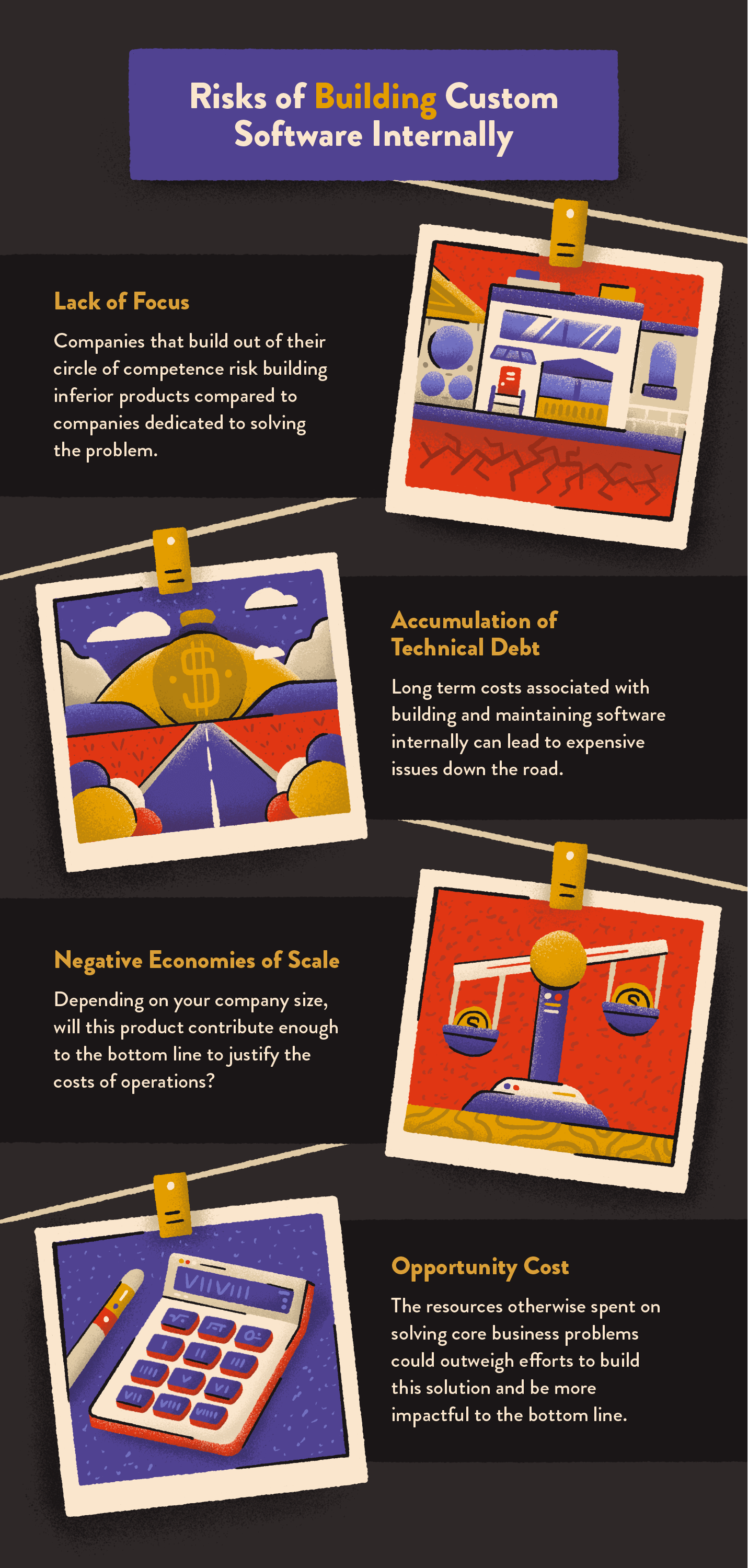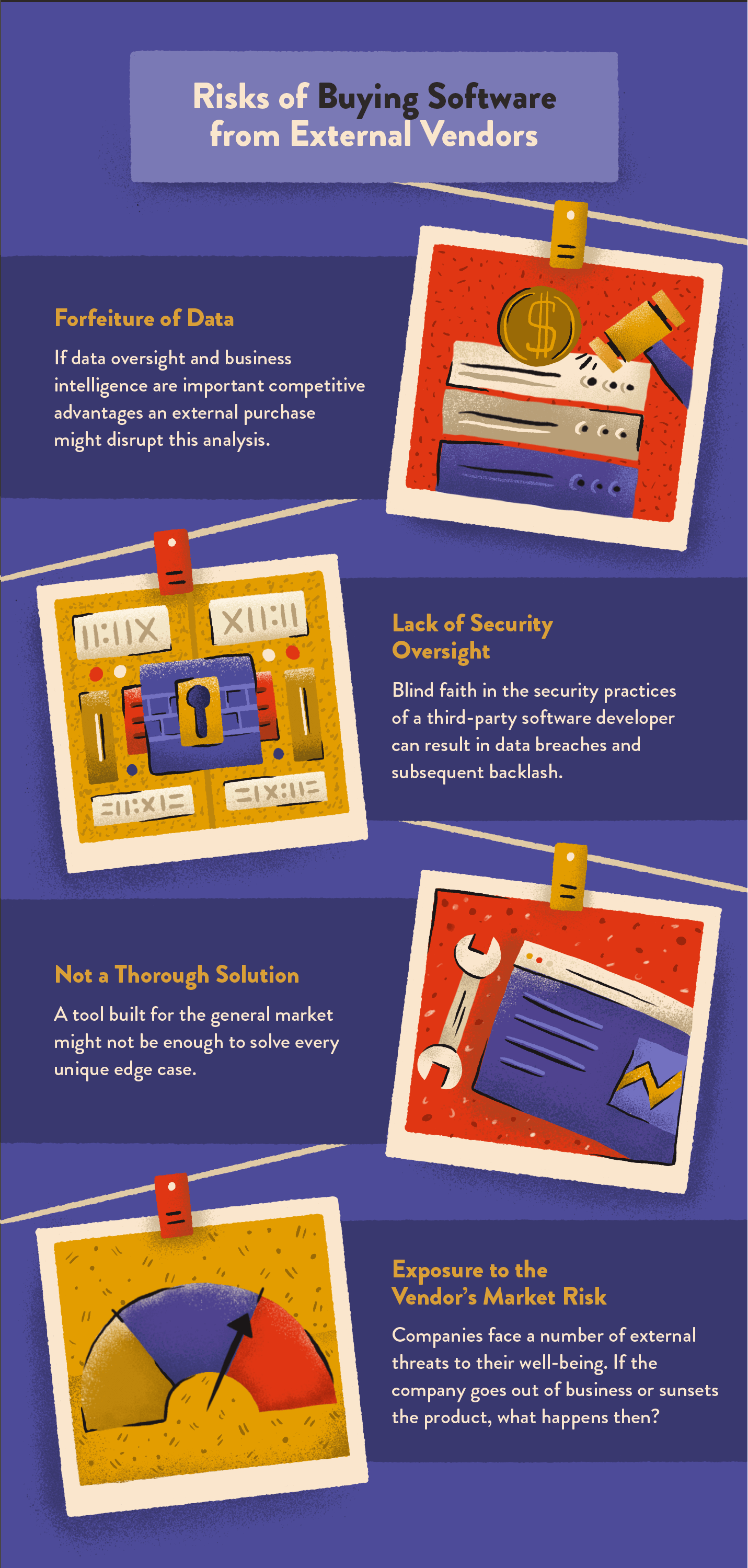To be built or to be bought, that is the question.
You are not alone. The software development conundrum of whether to build versus buy is more common than you may think.
While some companies appear to experience similar challenges, others face difficulties that are unique to them, which is why many software products won’t work for them out of the box.
Which puts us back in the hot seat of whether to build or buy.
In this article, we compare pros and cons to building custom software solutions internally or buying third party products. Continue reading for guidance in making the final decision for your company or jump to our infographic below.
Build vs. Buy Framework
Heads or tails?
The build vs. buy decision should not come down to the flip of a coin. Although there is still a 50% chance you will make the right decision, we want to increase those odds even further given your unique situation.
In this three-part framework, we cover the most important considerations when first deciding whether to build or buy. We then compare and contrast the pros and cons.
1. The Problem
The first thing to consider is the problem you are attempting to solve. Is this a common problem or a unique one facing your company specifically?
If it’s a common problem like mobile app retention, there will likely be many solutions to choose from. If it’s a problem specific to your company or industry, you may have trouble finding an existing workable solution.
Even if the problem is already well-addressed it’s possible your business needs fall within the edge cases not encompassed by the products currently on the market, which could be an argument for the decision to build.
2. The Budget
The next concern is budget. Most companies do not have a big budget for building enterprise-level software. This is why it can often be easier to justify a monthly recurring payment or even an annual expense for a third party product.
Let’s use the decision to buy or rent a home as an example. If you do not have the necessary funds to make a downpayment on a house, then it becomes necessary to rent, even if the rental fee is equivalent to what the mortgage payment would be.
When deciding if you should build a solution to your problem, the budget must include the long-term technical debt (mortgage) associated with hosting and maintaining your solution, in addition to the upfront costs (downpayment).
3. The Timeline
The next consideration is the time horizon. Is your problem a threat to the very livelihood of your company or just a nagging annoyance that could be improved? You must consider whether or not the problem will compromise the health of the business.
If you need a solution now, it can be an easy decision. Is there a solution in existence? If yes, buy it. If no, then, well… you’re going to have to build it as soon as possible.
There are risks awaiting you at every turn as you navigate this framework and ultimately make the final decision to build or buy. Let’s discuss some of these risks so you can make the most informed decision possible.
The Risks of Building
Remember not to use the elevator in the event of a fire.
Although we’re not talking about an actual building, there is definitely potential for dealing with fire — only this time in the metaphorical sense.
Some of the downfalls of building your own software solutions boil down to opportunity cost, quality concerns, and technical debt, among others. Let’s dig in.
Opportunity Cost
What could those additional resources be spent on?
When you allocate resources to building a solution, are you taking employees away from their most meaningful work? Your decision to build may be to the detriment of other projects.
If you are on the cutting-edge of machine learning and artificial intelligence, for example, your developers joined your mission-driven firm to solve these hard problems. If you take them away from these problems to build a user retention cohort dashboard, you will likely hurt morale and postpone any major technological breakthroughs.
Quality Compromise
If you decide to take on this project, will there be sufficient resources to see it through to completion? Building software takes time and money, and often, more time and money than expected.
If additional resources will not be available beyond the scope of the project, there is a chance it may not be fully functional (or functional at all) and may ultimately be a complete waste of time and money.
It’s also worth noting that the focus and efforts of your business are likely not dedicated to solving this exact problem, while some external software providers could be fully invested in this problem and therefore more likely to build a quality solution.
Technical Debt and Deficit
Technical debt, a common term in software development, is the obligation to fix inherently flawed software in the future. Technical debt can be taken on intentionally when a quick fix is not the ideal solution but necessary given the timeline and budget. Other times technical debt is the result of poor planning and architecture.
A technical deficit, a term we will introduce, is the lack of talent and finances needed to see a project through to completion. When technical debt becomes a technical deficit, the build quality can suffer, leading to lost time and money.
No Economies of Scale
Are you disadvantaged when it comes to sourcing tools that contribute to the build? Unanticipated expenses such as server fees and monthly database charges could be a huge risk of building.
Companies that service many customers are able to distribute the costs of software operations and maintenance evenly across their clients. These economies of scale can allow them to charge less for a product or service than you would be able to achieve by building it yourself.
If a third party’s economies of scale and other factors put your build at a disadvantage you may strongly consider the option to buy, but not before evaluating the risks associated with buying.
Risks of Buying
But it’s a risk-free trial.
A trial period is great for software targeting small businesses, but what about at the enterprise level? Implementing a trial for a large company can be difficult, which is why the product demo and price quote must be thorough and accurate.
Before moving forward with a trial, demo, or quote, review some of the surface level risks of buying a software solution versus building one yourself.
Forfeiture of Data
One important consideration to make when buying a software solution from a third party is data. In today’s ecosystem of privacy concerns and regulations, it’s more important than ever to ask: how will this third party use your proprietary data? Does this mean you lose access and oversight to important customer data and other business insights?
If your data is a vital component to your competitive advantage it becomes imperative to maintain this information internally.
External control of your data also leads to another risk of buying: security.
Security Risks
Can this third party be trusted? Are they using cybersecurity best practices?
Enterprise-level software companies are the targets (and often victims) of large-scale cyber attacks leading to millions of compromised accounts. In fact, the chances are pretty high that your data has been implicated in a cybersecurity breach of this kind.1
Even with security best practices, breaches do happen and it’s worth extra consideration before willingly bringing the trojan horse into your castle walls.
Not a Thorough Solution
Another risk of buying software from an external supplier is whether or not their solution adequately solves your company’s problem.
Let’s assume many companies face the same problem and the marketplace is saturated with options to choose from. It’s possible your particular use case has not been identified by these third parties.
Some companies may be open to customer feedback about future features but if your problem is limited to your niche, it’s unlikely the company will see your problem as a worthy addition.
Exposure to Partner’s Market Risk
Let’s say that you purchase a CRM tool and integrate it into your business development workflow. A year later that company comes to the conclusion they must raise prices or face going out of business. Six months after the price hike, they go out of business anyway.
And now you’re back, reading this article for clearer insight into the risks of buying.
When you use third-party vendors you need to have confidence in their ability to weather a market downturn or other external factors that may impact the health of their business.
Build or Buy… or Both?
There is an alternative to the build or buy dilemma, although very subjective: do both.
That’s right—do both. If you need a solution fast and there exists an external solution that would suffice, even if it does not meet 100% of your needs, consider whether it makes sense to pay the premium until your solution is built.
This option depends on favorable factors such as adequate budget, time horizon, and more. For example, you must consider whether the software is a subscription-based model and what the contract duration and cancellation terms are.
You should also consider discussing your problem with the external vendor to determine if there are already plans on their product roadmap to meet 100% of your needs. In that case, you can reevaluate the decision to build.
Build vs. Buy for Long and Short Term
Are you planning on your company being relevant in twenty, fifty, or even a hundred years?
If so, does this adjusted perspective impact your decision to build or buy? We know it can be difficult—okay, nearly impossible—to accurately predict what your company will look like in a hundred years. Even so, a failure to plan is a plan for failure, as they say.
Investing in building an infrastructure for your company can be the right decision for the long term as you scale and the economics of your software solution become more favorable. When you buy software from a third party it’s possible the pricing model does not scale quite as linearly.
On the other hand, sometimes buying from a third party turns out to be the right decision in the long term.
When you consider buying enterprise-level software it’s important to fully understand whether it is capable of solving your problem. Demand a demo and negotiate for pricing structure scalability into the future.
If you are in the market for a mobile marketing platform, CleverTap has built the most powerful tool for mobile marketing teams to gain valuable insights into their user data. With rich features like RFM analysis, customer journeys, triggered campaigns, and more, you can engage users, retain users, and even win back lost users.

See how today’s top brands use CleverTap to drive long-term growth and retention
Subharun Mukherjee 
Heads Cross-Functional Marketing.Expert in SaaS Product Marketing, CX & GTM strategies.
Free Customer Engagement Guides
Join our newsletter for actionable tips and proven strategies to grow your business and engage your customers.















































